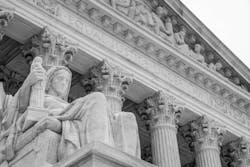Supreme Court justices skeptical of vaccine-or-test mandate
Judging by their Jan. 7 queries, a majority of U.S. Supreme Court justices sounded skeptical about the federal vaccine-or-test mandate—or “emergency temporary standard” (ETS)—set to take effect today nationwide. Justices questioned the sweeping scope of the ETS, stressing that such measures to battle the COVID-19 pandemic should come from Congress or states individually and not the single federal agency that actually put it out.
“It appears the federal government is going agency by agency because it can’t get Congress to act,” conservative Justice Neil Gorsuch said at one point during the back-and-forth on Jan. 7. “[Such a mandate] might be for the people’s representatives in the states and the halls of Congress.”
See also: Guide to the Supreme Court's hearing on federal vaccine-or-test rules
The rest of the conservative bloc of justices—Chief Justice John Roberts and Justices Brett Kavanaugh, Samuel Alito, Clarence Thomas, and Amy Coney Barrett—also questioned the scope of the mandate and the power of the Occupational Health and Safety Administration (OSHA) to issue it.
OSHA did so on Nov. 5, and since then, the action has been opposed by a wide array of business interests, including trucking groups such as American Trucking Associations (ATA) and state trucking associations, and other stakeholders such as several conservative state attorneys general and religious organizations.
These groups have been petitioners in litigation against the OSHA mandate, which has wound through various appeals courts—some that blocked, or “stayed,” enforcement of it (the conservative Louisiana-based 5th U.S. Circuit Court of Appeals, forcefully, on Nov. 12) and others that let the vaccine-or-test rules go forward (the more moderate 6th U.S. Circuit on Dec. 17 by a narrow 2-1 margin).
The mandate ultimately landed at the Supreme Court on Jan. 7—and the handicapping of what the High Court might decide began as soon as the oral arguments, carried live on C-SPAN, concluded. (The court also heard argument on the health-care worker vaccination requirement issued by the Centers for Medicare and Medicaid Services, and the justices seemed more likely to sustain that rule since it is more narrowly focused.)
Regarding the OSHA mandate that affects trucking, “it is always hard to predict what a ruling will look like based on oral arguments, but we’re confident that we made strong arguments that will compel the Court to agree with us that OSHA overstepped its authority in promulgating this emergency temporary standard,” Rich Pianka, ATA’s general counsel and chief of its litigation center, said in an email to members, the media, and other stakeholders.
“With the compliance deadline looming, we hope the Court will hand down a ruling quickly—or quickly enter another administrative stay of the upcoming enforcement deadlines—so that employers are not faced with any more uncertainty than they already are.”
In a similar email, David Heller, VP of government affairs for the Truckload Carriers Association, said: “The disruption this ETS would have on the trucking industry cannot be understated, and the Supreme Court will now weigh the arguments made by both the business community and the government.”
See also: Vaccine mandate heads to special Supreme Court hearing
“While we will not know the ultimate outcome of today’s oral arguments until a ruling is made, we remain hopeful that the Court will quickly strike down the ETS or reimpose the administrative stay in advance of the upcoming enforcement deadline.”
Before the arguments, observers viewed Chief Justice Roberts and Justices Barrett and Kavanaugh as members of the 6-3 conservative majority who might break and side with letting the mandate proceed starting in just three days, but none of them seemed overwhelmingly receptive to let that happen.
One such observer, Sean Marotta, a partner at Washington, D.C.-based Hogan Lovells and outside counsel for American Hospital Association who was live-blogging during the arguments, predicted via Twitter that the justices would block enforcement of the OSHA rules.
“It is hard to count to five votes in favor. It sounds like at least two of Roberts, Kavanaugh, and Barrett think it is too broad and intrudes too much on the police power of states,” Marotta wrote. “Median justices, however, may endorse a targeted regulation aimed at specific higher-risk workplaces."
Barrett at one point also did come down on the side of OSHA rules targeted more at specific industries. “The rule needs to be more targeted,” she said. “The problem is its scope.”
Other justices questioned the need for an emergency stay—meaning an immediate halt to the mandate. Scott Keller, a former Texas solicitor general and attorney for the National Federation for Independent Business (NFIB), argued forcefully for immediate relief, and NFIB was among the petitioners for such immediate action. Keller presented most of the arguments on Jan. 7 in opposition to the OSHA mandate. He also was joined at points by Benjamin Flowers, Ohio’s solicitor general.
“We need a stay now,” Keller said, adding that compliance “can’t take place overnight.”
Keller would argue later that “this is going to cause a massive shift in the economy”—adding that not enough testing facilities and supplies existed for employees to conform to the OSHA rules.
Justice Gorsuch asked Keller why the petitioners required an immediate stay of the OSHA mandate. Keller answered: “Workers will quit, that will ripple through the national economy.”
U.S. Solicitor General Elizabeth Prelogar defended the rules Friday before the High Court, saying that Congress had already vested the agency, in federal law, with the authority to institute a mandate as sweeping as the one OSHA issued on Nov. 5.
As of Monday, Jan. 10, if the OSHA rules stay in force and aren’t interrupted by a Supreme Court decision, employers can be penalized for not following them. OSHA has stated that it will not cite companies based on the testing requirements until Feb. 9.
Urgency at the court because the rules phase in within days
The OSHA rules are expected to affect 84 million employees nationwide.
They cover businesses with 100 or more employees and require workers to be vaccinated—and for employers to document those shots—and for unvaccinated employees to submit to weekly testing for COVID-19. The rules do not require employers to foot the bill for the testing, but companies must provide paid time off (up to four hours) for workers who get the shot and paid sick days if they experience common side effects.
The OSHA ETS does exempt certain employees, such as those who work from home or who primarily do their jobs outdoors. And ATA President and CEO Chris Spear received informal advice from Labor Secretary Marty Walsh that truck drivers would be exempt as well, though Spear reported Jan. 4 that the Labor Department had yet to formally codify this. Many other trucking industry employees—such as those who work at fleet facilities, terminals and warehouses, and commercial vehicle maintenance facilities—would still have to comply, according to OSHA.
During their questioning on Jan. 7 of advocates Keller, Flowers, and Prelogar, progressive Justices Stephen Breyer, Sonia Sotomayor, and Elena Kagan came down forcefully in favor of OSHA’s authority to issue its mandate and reminded all within listening range of the extraordinary circumstances that the pandemic had forced on Americans, outside and inside workplaces. More than one justice repeated the “grave danger” of the pandemic and the latest COVID-19 variants to justify rules as sweeping as OSHA’s.
“Three quarters of a million new cases [were reported] just yesterday, 10 times as many as when OSHA issued the ETS,” Breyer noted. “Hospitals are filled with people who are unvaccinated. Is it in the public interest to ask us in this situation to issue a stay? I find that unbelievable.”
“I don’t understand why the ETS isn’t necessary,” Kagan said. “This is a pandemic … this is the gravest public-health emergency that the country has faced in at least 100 years. This is the policy that is most geared toward preventing this. Why isn’t this necessary and grave? It’s an extraordinary use of power under an extraordinary circumstance.”
Kagan asked NFIB’s Keller at one point: “What else should be done? It’s obvious that [the OSHA ETS] is geared toward preventing more sickness or death.”
Sotomayor added: “We are now having deaths at an unprecedented amount.”
Kagan conceded to Keller that there are trade-offs with the mandate and its profound impact on the economy, as the rules’ opponents, including trucking stakeholders, have argued. But Kagan argued the OSHA mandates are “well-supported” and that OSHA is the most “politically accountable agency”—"full of experts on COVID-19 and its impact on workplaces.”
“This is a politically accountable policy,” she added. "Courts are not politically accountable. Why in the world would courts decide this question? OSHA has a lot of knowledge about the dangers that employees face.”
At another point, Kagan said the risk of COVID-19 exposure is greatest in workplaces, where “you must be there for eight hours a day, in that exact environment. Where else do people have a greater risk than the workplace?”
And one point, Ohio solicitor Flowers called the OSHA mandate a “blunderbuss rule.” But again, Kagan countered: “Do you know of workplace that hasn’t fundamentally transformed over the last two years? Every workplace [has dealt] with COVID … everyone has sent people home. I’m trying to figure out why this is a blunderbuss approach.”
About the Author
Scott Achelpohl
Managing Editor
Scott Achelpohl is a former FleetOwner managing editor who wrote for the publication from 2021 to 2023. Since 2023, he has served as managing editor of Endeavor Business Media's Smart Industry, a FleetOwner affiliate.

